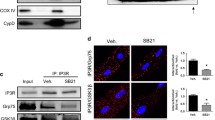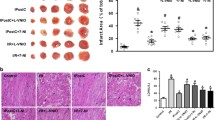Abstract.
Rat neonatal ventricular myocytes exposed to simulated ischaemia and reperfusion (SI/R) were used as an in vitro model to delineate the role(s) of extracellular signal–regulated kinase (ERK), p38 and c–Jun NH2–terminal protein kinase (JNK), as well as PKB in apoptosis. Exposure of the myocytes to SI (simulated ischaemia – energy depletion induced by KCN and 2-deoxy-D–glucose) reduced cell viability, as measured by the 3–[4,5–dimethylthiazol–2–yl]–2,5–diphenyl tetrazolium bromide (MTT) assay, and stimulated apoptosis as evidenced by caspase–3 activation and poly(ADP–ribose) polymerase (PARP) cleavage. However, morphological evidence of increased apoptosis, detected by staining with Hoechst 33342, was only seen in response to reperfusion. This suggests that although ischaemic conditions are sufficient to induce cellular markers of apoptosis (PARP cleavage and caspase–3 activation), reperfusion is required to complete the apoptotic pathway in these cells. Furthermore, SI resulted in a rapid, strong, biphasic activation of p38 concomitant with a weak and transient activation of the two ERK isoenzymes, p42/p44–MAPK. Reperfusion for 5 minutes resulted in a strong phosphorylation of p42/p44–MAPK, while no additional p38 activation was seen at this stage. On the other hand, p46/p54–MAPK (JNK) was phosphorylated in response to 5 minutes of reperfusion only and not during SI alone. A peak of PKB/Akt (Ser473) activity was seen within 5 minutes of exposure to SI, whereas PKB/Akt (Thr308) phosphorylation remained at the baseline level. Both PKB/Akt phosphorylation sites (Ser473 and Thr308) were phosphorylated after 5 minutes of reperfusion. Inhibition of PI–3–kinase activity, using wortmannin, decreased phosphorylation on both sites during SI. However, only SI/R-induced PKB/Akt phosphorylation on Thr308 was reduced by wortmannin. Myocytes pre–treated with SB203580, a p38–inhibitor, displayed a significant increase in cell viability [63.67 ± 1.85 to 84.33 ± 4.8% (p < 0.05)] and attenuation of the apoptotic index during SI/R [22.6 ± 2.94% to 9 ± 0.43% (p < 0.001)], while SP600125, a specific JNK inhibitor, caused a significant increase in caspase–3 activation [1.66 ± 0.03 fold to 2.56 ± 0.27 fold (p < 0.001)] and apoptotic index [22.6 ± 2.94% to 32.75 ± 6.13% (p < 0.05)]. However, PD98059, an ERK inhibitor, failed to affect apoptosis during SI/R. Inhibition of PI–3–kinase prevented the increase in mitochondrial viability usually observed during reperfusion. Interestingly, wortmannin caused a significant increase in PARP cleavage during reperfusion, but had no effect on caspase–3 activation or the apoptotic index. Our results suggest that p38 has a pro–apoptotic role while JNK phosphorylation is protective in our cell model and that these kinases act via caspase–3 to prevent or promote cell survival in response to SI/R–induced injury.
Similar content being viewed by others
References
Abe J, Baines CP, Berk BC (2000) Role of mitogen-activated protein kinases in ischemia and reperfusion injury. Circ Res 86:607–609
Alessi DR, Andjelkovic M, Caudwell B, Cron P, Morrice N, Cohen P, Hemmings BA (1996) Mechanism of activation of protein kinase B by insulin and IGF-1. EMBO J 15 (23):6541–6551
Anderson KE, Coadwell J, Stephens LR, Hawkins PT (1998) Translocation of PDK-1 to the plasma membrane is important in allowing PDK-1 to activate protein kinase B. Curr Biol 8:684–691
Anversa P, Kajstura J (1998) Myocyte cell death in the diseased heart. Circ Res 82:1231–1233
Bogoyevitch MA, Gillespie-Brown J, Ketterman AJ, Fuller SJ, Ben-Levy R, Ashworth A, Marshall CJ, Sugden PH (1996) Stimulation of the stress-activated mitogen-activated protein kinase subfamilies in perfused heart: p38/ERK mitogen- activated protein kinases and c-Jun N-terminal kinases are activated by ischemia/reperfusion. Circ Res 79:162–173
Bonni A, Brunet A, West AE, Datta SR, Takasu MA, Greenberg ME (1999) Cell survival promoted by the Ras-MAPK signalling pathway by transcriptiondependent and -independent mechanisms. Science 289:1358–1362
Bradford MM (1976) A rapid and sensitive method for quantitation of microgram quantities of protein utilizing the principle of protein-dye binding. Anal Biochem 71:248–254
Chaudhary PM, Eby MT, Jasmin A, Hood L (1999) Activation of c-Jun N-terminal kinase/stress-activated protein kinase pathway by overexpression of caspase-8 and its homologs. J Biol Chem 274:19211–19219
Clerk A, Sugden PH (1998) The p38- MAPK inhibitor, SB203580, inhibits cardiac stress-activated protein kinase/c-Jun N-terminal kinases (SAPKs/JNKs). FEBS Lett 426:93–96
Datta SR, Dudek H, Tao X, Masters S, Fu H, Gutoh Y, Greenberg ME (1997) Akt phosphorylation of BAD couples survival signals to the cell-intrinsic death machinery. Cell 91:231–241
Del Peso L, Gonzales-Gracia M, Page C, Herrera R, Nunez G (1997) Interleukin-3 induced phosphorylation of BAD through protein kinase Akt. Science 278:687–689
Dougherty CJ, Kubasiak LA, Prentice H, Andreka P, Bishopric NH, Webster KA (2002) Activation of c-Jun N-terminal kinase promotes survival of cardiac myocytes after oxidative stress. Biochem J 362:561–571
Dudley DT, Pang L, Decker SJ, Bridges AJ, Saltiel AR (1995) A synthetic inhibitor of the mitogen-activated protein kinase cascade. Proc Natl Acad Sci USA 92:7686–7689
Edoute Y, van der Merwe E, Sanan D, Kotze JCN, Steinmann C, Lochner A (1983) Normothermic ischemic cardiac arrest of the isolated working heart. Circ Res 53:663–678
Fiordaliso F, Leri A, Cesselli D, limana F, Safai B, Nadal-Ginard B, Anversa P, Kajstura J (2001) Hyperglycemia activates p53 and p53-regulated genes leading to myocyte death. Diabetes 50 (10):2363– 2375
Frodin M, Gammeltoft S (1999) Role and regulation of 90 kDa ribosomal S6 kinase (RSK) in signal transduction. Mol Cell Endocrinol 151:65–77
Fujio Y, Nguyen T, Wencker D, Kitsis RN, Walsh K (2000) Akt promotes survival of cardiomyocytes in vitro and protects against ischemia-reperfusion injury in mouse heart. Circulation 101:660–667
Gomez LA, Alekseev AE, Aleksandrova LA, Brady PA, Terzic A (1997) Use of MTT assay in adult ventricular cardiomyocytes to assess viability: Effects of Adenosine and Potassium on cellular survival. J Mol Cell Cardiol 29:1255–1266
Gottlieb RA, Engler RL (1999) Apoptosis in myocardial ischemia-reperfusion. Ann NY Acad Sci 874:412–426
Han H, Wang, H, Long H, Nattel S, Wang Z (2001) Oxidative preconditioning and apoptosis in L-cells. Roles of protein kinase B and mitogen-activated protein kinases. J Biol Chem 276:26357–26364
He H, Li H-L, Lin A, Gotllieb RA (1999) Activation of the JNK pathway is important for cardiomyocyte death in response to simulated ischemia. Cell Death Differ 6:987–991
Hill MM, Andjelkovic M, Brazil DP, Ferrari S, Fabbro D, Hemmings BA (2001) Insulin-stimulated protein kinase B phosphorylation on Ser-473 is independent of its activity and occurs through a staurosporine-insensitive kinase. J Biol Chem 276:25643–25646
Hreniuk D, Garay M, Garrde W, Monia BP, McKay RA, Ciof. CL (2001) Inhibition of c-Jun N-terminal kinase 1, but not c-Jun N-terminal kinase 2, suppresses apoptosis induced by ischaemia/reperfusion in rat cardiac myocytes. Mol Pharmacol 59:867–874
Kajstura JW, Cheng K, Reiss WA, Clark EH, Sonnenblick S, Krajewski JC, Reed G, Olivetti G, Anversa P (1996) Apoptotic and necrotic myocyte cell deaths are independent contributing variables of infarct size in rats. Lab Invest 74:86–107
Kostin S, Pool L, Elsässer A, Hein S, Drexler HCA, Arnon E, Hayakawa Y, Zimmerman R, Bauer E, Klövekorn W-P, Schaper J (2003) Myocytes die by multiple mechanisms in failing human hearts. Circ Res 92:715–724
Leppa S, Saffrich R, Ansorge W, Bohmann D (1998) Differential regulation of cJun by ERK and JNK during PC12 cell differentiation. EMBO J 17:4404–4413
Lowry AO, Rosenbrough NJ, Farr AL, Randall RJ (1951) Protein determination with the folin phenol reagent. J Biol Chem 193:265–275
Mackay K, Mochly-Rosen D (2000) Involvement of p38 mitogen-activated protein kinase phosphatase in protecting neonatal rat cardiac myocytes from ischemia. J Mol Cell Cardiol 32:1585–1588
Mansour SJ, Matten WT, Herman AS, Candia JM, Rong S, Fukasawa K, Vande Woude GF, Ahn NG (1994) Transformation of mammalian cells by constitutively active MAP kinase kinase. Science 265:966–970
Marais E, Genade S, Huisamen B, Strijdom JG, Moolman JA, Lochner A (2001) Activation of p38-MAPK induced by a multi-cycle ischaemic preconditioning protocol is associated with attenuated p38-MAPK activity during sustained ischaemia and reperfusion. J Mol Cell Cardiol 33:769–778
Michel MC, Li Y, Heusch G (2001) Mitogen- activated protein kinases in the heart. Naunyn-Schmiedeberg’s Arch Pharmacol 363:245–266
Minamino T, Yuiri T, Papst PJ, Chan ED, Johnson GL, Terada N (1999) MEKK1 suppresses oxidative stress-induced apoptosis of embryonic stem cell-derived cardiac myocytes. Proc Natl Acad Sci USA 26:15127–15132
Nakano A, Cohen MV, Critz S, Downey JM (2000) SB203580, an inhibitor of p38 MAPK, abolishes infarct-limiting effects of ischemic preconditioning in isolated rabbit hearts. Basic Res Cardiol 95:466– 471
Obata T, Brown GE, Yaffe MB (2000) MAP kinase pathways activated by stress: the p38 MAPK pathway. Crit Care Med 28:N67–N77
Park WH, Seol JG, Kim ES, Hyun JM, Jung CW, Lee CC, Binderup L, Koefer HP, Kim BK, Lee YY (2000) Induction of apoptosis by vitamin D3 analogue EB1089 in NCIH929 myeloma cells via activation of caspase- 3 and p38-MAPK. British J Haem 109:576–583
Pinson A (1990) Neonatal rat heart muscle cells. In: Piper HM (ed) Cell culture techniques in heart and vessel research. Springer Berlin Heidelberg New York London Paris Tokyo Hong Kong, pp 20–35
Punn A, Mockridge JW, Farooqui S, Marber MS, Heads RJ (2000) Sustained activation of p42/p44 mitogen-activated protein kinase during recovery from simulated ischaemia mediates adaptive cytoprotection in cardiomyocytes. Biochem J 350:891–899
Sato M, Cordis GA, Maulik N, Das DK (2000) SAPKs regulation of ischemic preconditioning. Am J Physiol Heart Circ Physiol 279:H901–H907
Saurin AT, Martin JC, Heads RJ, Foley C, Mockridge JW, Wright MJ, Wang Y, Marber S (2000) The role of differential activation of p38 mitogen activated protein kinase in preconditioned ventricular myocytes. Faseb J 14:2237–2246
Schaper J, Elsässer A, Kostin S (1999) The role of cell death in heart failure. Circ Res 85:867–869
Schaper J, Lorenz-Meyer S, Suzuki K (1999) The role of apoptosis in dilated cardiomyopathy. Herz 24:219–224
Scheid MP, Duronio V (1998) Dissociation of cytokine-induced phophorylation of BAD and activation of PKB/Akt: involvement of MEK upstream of BAD phosphorylation. Proc Natl Acad Sci USA 95:7439–7444
Shiraishi J, Tatsumi T, Keira N, Akashi K, Mano A, Yamanak S, Matabo S, Asayama J, Yaoi T, Fushiki S, Fliss H, Nakagawa M (2001) Important role of energy-dependent mitochondrial pathways in cultured rat cardiac myocyte apoptosis. Am J Physiol Heart Physiol 281:H1637–H1647
Schulz R, Belosjorow S, Gres P, Jansen J, Michel MC, Heusch G (2002) p38 MAP kinase is a mediator of ischemic preconditioning in pigs. Cardiovasc Res 55:690–700
Torcia M, De Chiara G, Nencioni L, Ammendola S, Labardi D, Lucibello M, Sharba PD (2001) Nerve growth factor inhibits apoptosis in memory B lymphocytes via inactivation of p38 MAPK, prevention of Bcl-2 phosphorylation, and cytochrome c release. J Biol Chem 276:39027–39036
Vaishnav D, Jambal P, Reusch JE, Pugazhenthi S (2003) SP600125, an inhibitor of c-jun N-terminal kinase, activates CREB by a p38 MAPK-mediated pathway. Biochem Biophys Res Commun 307 (4):855–860
Versteeg HH, Evertzen MWA, van Deventer SJH, Peppelenbosch MP (2000) The role of phosphatidylinositide-3-kinase in basal mitogen-activated protein kinase activity in cell survival. FEBS Letters 465:69–73
Victor P, Bester AJ, Lochner A (1987) A sensitive and rapid method for separating adenine nucleotide and creatine phosphate by ion-pair-reversed-phased highperformance liquid chromatography. J Chromatogr 389:339–344
Wang Y, Huang S, Sah VP, Ross J, Brown JH, Han J, Chien KR (1998) Cardiac muscle cell hyperthrophy and apoptosis induced by distinct members of the p38 mitogen-activated protein kinase family. J Biol Chem 273:2161–2168
Wang Y, Su B, Sah VP, Brown JH, Han J, Chien KR (1998) Cardiac hyperthrophy induced by mitogen-activated protein kinase 7, a specific activator for c-Jun NH2-terminal kinase in ventricular muscle. J Biol Chem 273:5423–5426
Weinbrenner C, Liu GS, Cohen MV, Downey JM (1997) Phosphorylation of tyrosine 182 of p38 mitogen-activated protein kinase correlates with the protection of preconditioning in the rabbit heart. J Mol Cell Cardiol 29:2823–2391
Yue T-L, Wang C, Gu J-L, Ma X-L, Kumar S, Lee JC, Feuerstein GZ, Thomas H, Maleeff B, Ohlstein EH (2000) Inhibition of extracellular signal-regulated kinase enhances ischemia/reoxygenationinduced apoptosis in cultured cardiac myocytes and exaggerates reperfusion injury in isolated perfused heart. Circ Res 86:692–699
Author information
Authors and Affiliations
Corresponding author
Rights and permissions
About this article
Cite this article
Engelbrecht, AM., Niesler, C., Page, C. et al. p38 and JNK have distinct regulatory functions on the development of apoptosis during simulated ischaemia and reperfusion in neonatal cardiomyocytes. Basic Res Cardiol 99, 338– 350 (2004). https://doi.org/10.1007/s00395-004-0478-3
Received:
Revised:
Accepted:
Published:
Issue Date:
DOI: https://doi.org/10.1007/s00395-004-0478-3




